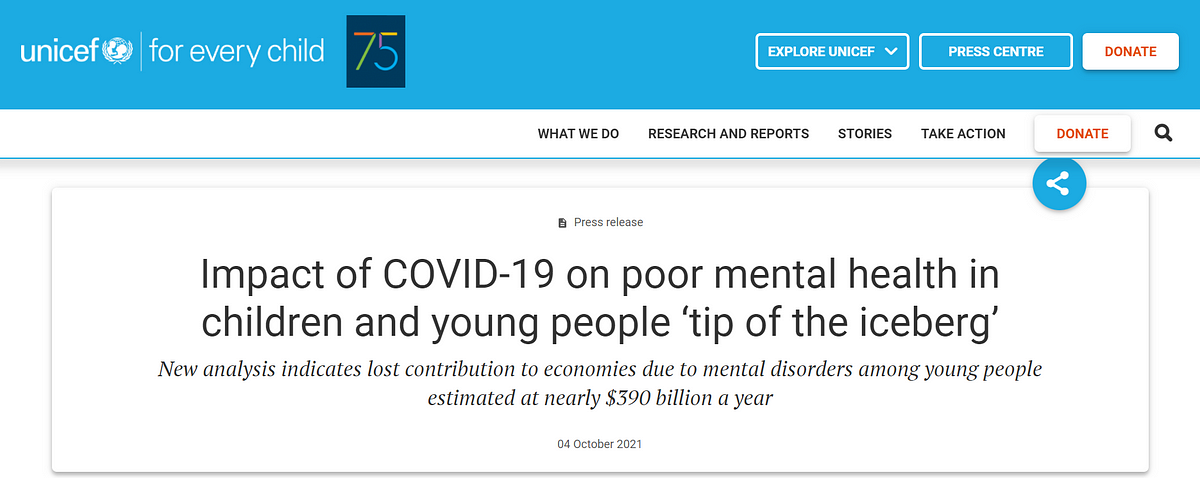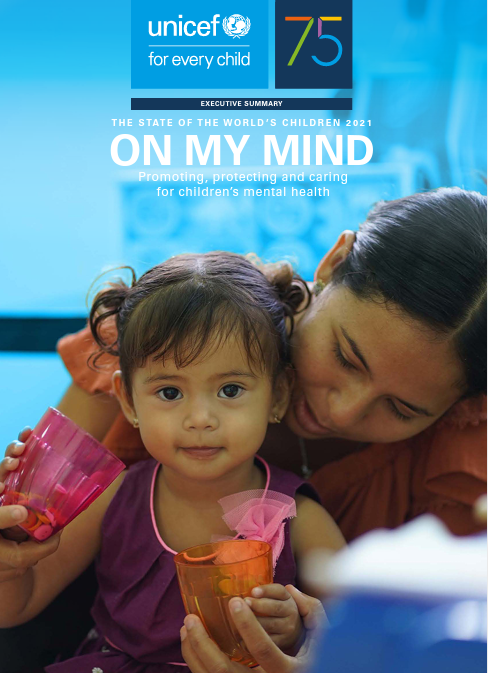The Health Strategist
Joaquim Cardoso, MSc
October 12, 2021
This is a one page summary of the article on the 2nd part of this post.
Key messages
What is the problem?
- Children and young people could feel the impact of COVID-19 on their mental health and well-being for many years to come, UNICEF warned in its flagship report today.
- According to the latest available estimates, more than 1 in 7 adolescents aged 10–19 (14%) is estimated to live with a diagnosed mental disorder globally.
- Almost 46,000 adolescents die from suicide each year, among the top five causes of death for their age group.
- Meanwhile, wide gaps persist between mental health needs and mental health funding.
- New analysis indicates lost contribution to economies due to mental disorders among young people estimated at nearly $390 billion a year
What is the context:
- Even before COVID-19, children and young people carried the burden of mental health conditions without significant investment in addressing them.
What are the causes?
- A mix of genetics, experience and environmental factors from the earliest days, including parenting, schooling, quality of relationships, exposure to violence or abuse, discrimination, poverty, humanitarian crises, and health emergencies such as COVID-19, all shape and effect children’s mental health throughout their lifetime.
- While protective factors, such as loving caregivers, safe school environments, and positive peer relationships can help reduce the risk of mental disorders, the report warns that significant barriers, including stigma and lack of funding, are preventing too many children from experiencing positive mental health or accessing the support they need.
What are the issues?
- Too little investment is being made by governments to address these critical needs. Not enough importance is being placed on the relationship between mental health and future life outcomes.”
- The report finds that about 2 per cent of government health budgets are allocated to mental health spending globally.
What are the recommendations?
The State of the World’s Children 2021 calls on governments, and public and private sector partners, to commit, communicate and act to promote mental health for all children, adolescents and caregivers, protect those in need of help, and care for the most vulnerable, including:
- Urgent investment in child and adolescent mental health across sectors, not just in health, to support a whole-of-society approach to prevention, promotion and care.
- Integrating and scaling up evidence-based interventions across health, education and social protection sectors — including parenting programmes that promote responsive, nurturing caregiving and support parent and caregiver mental health; and ensuring schools support mental health through quality services and positive relationships.
- Breaking the silence surrounding mental illness, through addressing stigma and promoting better understanding of mental health and taking seriously the experiences of children and young people.
ORIGINAL PUBLICATION

Impact of COVID-19 on poor mental health in children and young people ‘tip of the iceberg’
New analysis indicates lost contribution to economies due to mental disorders among young people estimated at nearly $390 billion a year
Unicef
04 October 2021
Henrietta Fore, UNICEF Executive Director
NEW YORK, 5 October 2021
Children and young people could feel the impact of COVID-19 on their mental health and well-being for many years to come, UNICEF warned in its flagship report today.
According to The State of the World’s Children 2021; On My Mind: promoting, protecting and caring for children’s mental health — UNICEF’s most comprehensive look at the mental health of children, adolescents and caregivers in the 21st century — even before COVID-19, children and young people carried the burden of mental health conditions without significant investment in addressing them.
According to the latest available estimates, more than 1 in 7 adolescents aged 10–19 is estimated to live with a diagnosed mental disorder globally. Almost 46,000 adolescents die from suicide each year, among the top five causes of death for their age group. Meanwhile, wide gaps persist between mental health needs and mental health funding. The report finds that about 2 per cent of government health budgets are allocated to mental health spending globally.
“It has been a long, long 18 months for all of us — especially children. With nationwide lockdowns and pandemic-related movement restrictions, children have spent indelible years of their lives away from family, friends, classrooms, play — key elements of childhood itself,” said UNICEF Executive Director Henrietta Fore.
“The impact is significant, and it is just the tip of the iceberg.
Even before the pandemic, far too many children were burdened under the weight of unaddressed mental health issues.
Too little investment is being made by governments to address these critical needs. Not enough importance is being placed on the relationship between mental health and future life outcomes.”
Too little investment is being made by governments to address these critical needs. Not enough importance is being placed on the relationship between mental health and future life outcomes.”
Children’s mental health during COVID-19
Indeed, the pandemic has taken its toll. According to early findings from an international survey of children and adults in 21 countries conducted by UNICEF and Gallup — which is previewed in The State of the World’s Children 2021 — a median of 1 in 5 young people aged 15–24 surveyed said they often feel depressed or have little interest in doing things.
As COVID-19 heads into its third year, the impact on children and young people’s mental health and well-being continues to weigh heavily.
According to the latest available data from UNICEF, globally, at least 1 in 7 children has been directly affected by lockdowns, while more than 1.6 billion children have suffered some loss of education.
The disruption to routines, education, recreation, as well as concern for family income and health, is leaving many young people feeling afraid, angry, and concerned for their future.
For example, an online survey in China in early 2020, cited in The State of the World’s Children, indicated that around a third of respondents reported feeling scared or anxious.
Cost to society
Diagnosed mental disorders, including ADHD, anxiety, autism, bipolar disorder, conduct disorder, depression, eating disorders, intellectual disability, and schizophrenia, can significantly harm children and young people’s health, education, life outcomes, and earning capacity.
While the impact on children’s lives is incalculable, a new analysis by the London School of Economics in the report indicates that lost contribution to economies due to mental disorders that lead to disability or death among young people is estimated at nearly $390 billion a year.
Protective factors
The report notes that a mix of genetics, experience and environmental factors from the earliest days, including parenting, schooling, quality of relationships, exposure to violence or abuse, discrimination, poverty, humanitarian crises, and health emergencies such as COVID-19, all shape and effect children’s mental health throughout their lifetime.
While protective factors, such as loving caregivers, safe school environments, and positive peer relationships can help reduce the risk of mental disorders, the report warns that significant barriers, including stigma and lack of funding, are preventing too many children from experiencing positive mental health or accessing the support they need.
The State of the World’s Children 2021 calls on governments, and public and private sector partners, to commit, communicate and act to promote mental health for all children, adolescents and caregivers, protect those in need of help, and care for the most vulnerable, including:
- Urgent investment in child and adolescent mental health across sectors, not just in health, to support a whole-of-society approach to prevention, promotion and care.
- Integrating and scaling up evidence-based interventions across health, education and social protection sectors — including parenting programmes that promote responsive, nurturing caregiving and support parent and caregiver mental health; and ensuring schools support mental health through quality services and positive relationships.
- Breaking the silence surrounding mental illness, through addressing stigma and promoting better understanding of mental health and taking seriously the experiences of children and young people.
“Mental health is a part of physical health — we cannot afford to continue to view it as otherwise,” said Fore.
“For far too long, in rich and poor countries alike, we have seen too little understanding and too little investment in a critical element of maximizing every child’s potential. This needs to change.”
Notes to Editors
Estimates on causes of death among adolescents are based on data from the World Health Organization (WHO) 2019 Global Health Estimates. Estimates on prevalence of diagnosed mental disorders are based on the Institute of Health Metrics and Evaluation’s (IHME) 2019 Global Burden of Disease Study.
Survey findings on feelings of depression or having little interest in doing things are part of a larger study conducted jointly between UNICEF and Gallup to explore the intergenerational divide. The Changing Childhood Project interviewed approximately 20,000 people by telephone in 21 countries. All samples are probability-based and nationally representative of two distinct populations in each country: people aged 15–24 and people aged 40 and older. The coverage area is the entire country, including rural areas, and the sampling frame represents the entire civilian, non-institutionalized, population within each age cohort with access to a telephone. The full findings of the project will be released by UNICEF in November.
Originally published at https://www.unicef.org.
ORIGINAL REPORT

The State of the World’s Children 2021
As we enter the third year of the pandemic, the disruption to routines, education, recreation, as well as concern for…www.unicef.org












